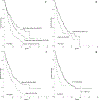Outcomes of patients with multiple myeloma refractory to CD38-targeted monoclonal antibody therapy
- PMID: 30858549
- PMCID: PMC6820050
- DOI: 10.1038/s41375-019-0435-7
Outcomes of patients with multiple myeloma refractory to CD38-targeted monoclonal antibody therapy
Abstract
The introduction of CD38-targeting monoclonal antibodies (CD38 MoABs), daratumumab and isatuximab, has significantly impacted the management of patients with multiple myeloma (MM). Outcomes of patients with MM refractory to CD38 MoABs have not been described. We analyzed outcomes of 275 MM patients at 14 academic centers with disease refractory to CD38 MoABs. Median interval between MM diagnosis and refractoriness to CD38 MoAB (T0) was 50.1 months. The median overall survival (OS) from T0 for the entire cohort was 8.6 [95% C.I. 7.5-9.9] months, ranging from 11.2 months for patients not simultaneously refractory to an immunomodulatory (IMiD) agent and a proteasome inhibitor (PI) to 5.6 months for "penta-refractory" patients (refractory to CD38 MoAB, 2 PIs and 2 IMiDs). At least one subsequent treatment regimen was employed after T0 in 249 (90%) patients. Overall response rate to first regimen after T0 was 31% with median progression-free survival (PFS) and OS of 3.4 and 9.3 months, respectively. PFS was best achieved with combinations of carfilzomib and alkylator (median 5.7 months), and daratumumab and IMiD (median 4.5 months). Patients with MM refractory to CD38 MoAB have poor prognosis and this study provides benchmark for new therapies to be tested in this population.
Conflict of interest statement
Conflicts of Interest
The remaining authors have no conflict of interest to disclose.
Figures


References
-
- Moreau P. How I treat myeloma with new agents. Blood 2017. September 28; 130(13): 1507–1513. - PubMed
-
- Kumar SK, Dimopoulos MA, Kastritis E, Terpos E, Nahi H, Goldschmidt H, et al. Natural history of relapsed myeloma, refractory to immunomodulatory drugs and proteasome inhibitors: a multicenter IMWG study. Leukemia 2017. November; 31(11): 2443–2448. - PubMed
MeSH terms
Substances
Grants and funding
LinkOut - more resources
Full Text Sources
Other Literature Sources
Medical
Research Materials
Miscellaneous

